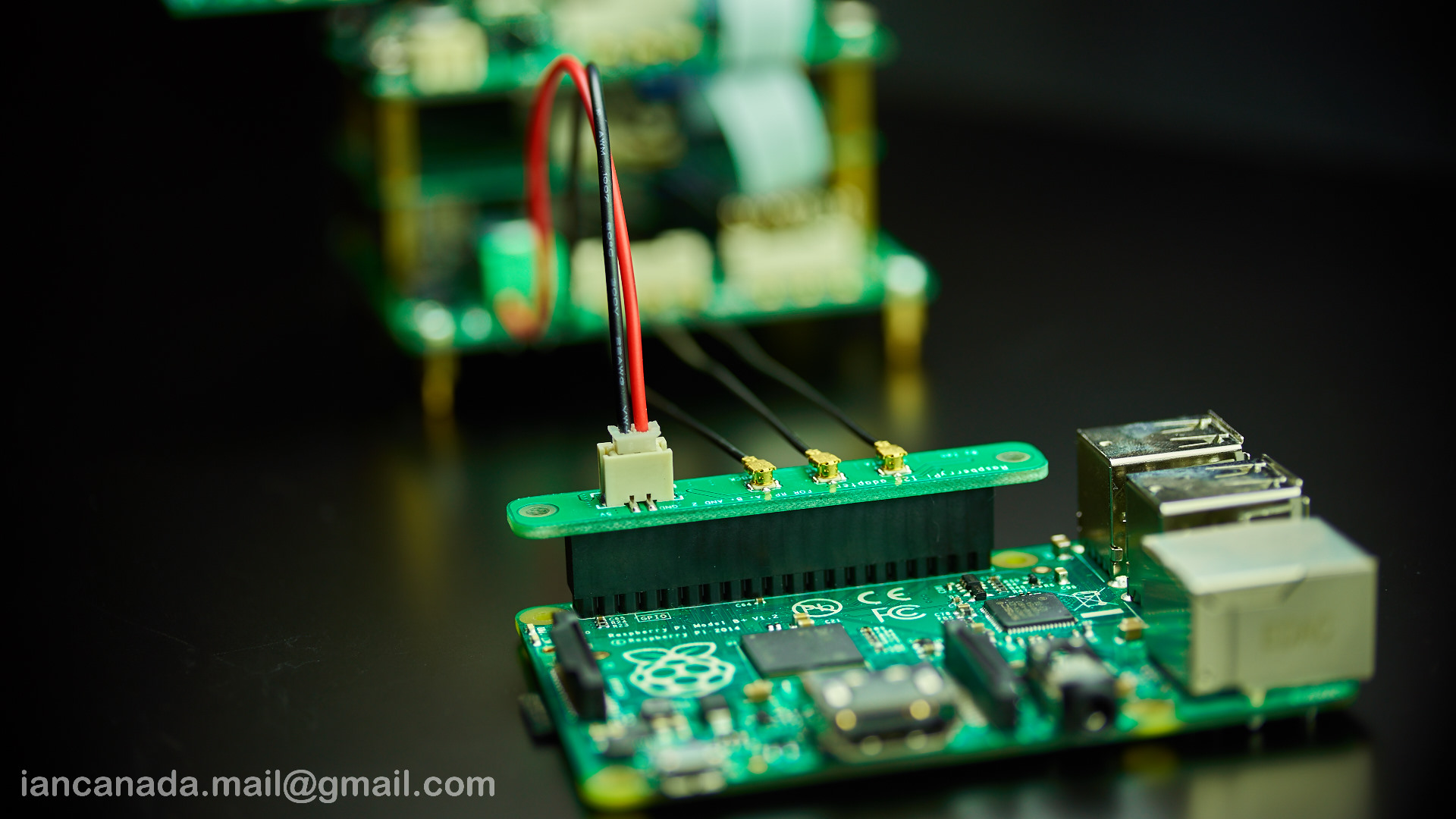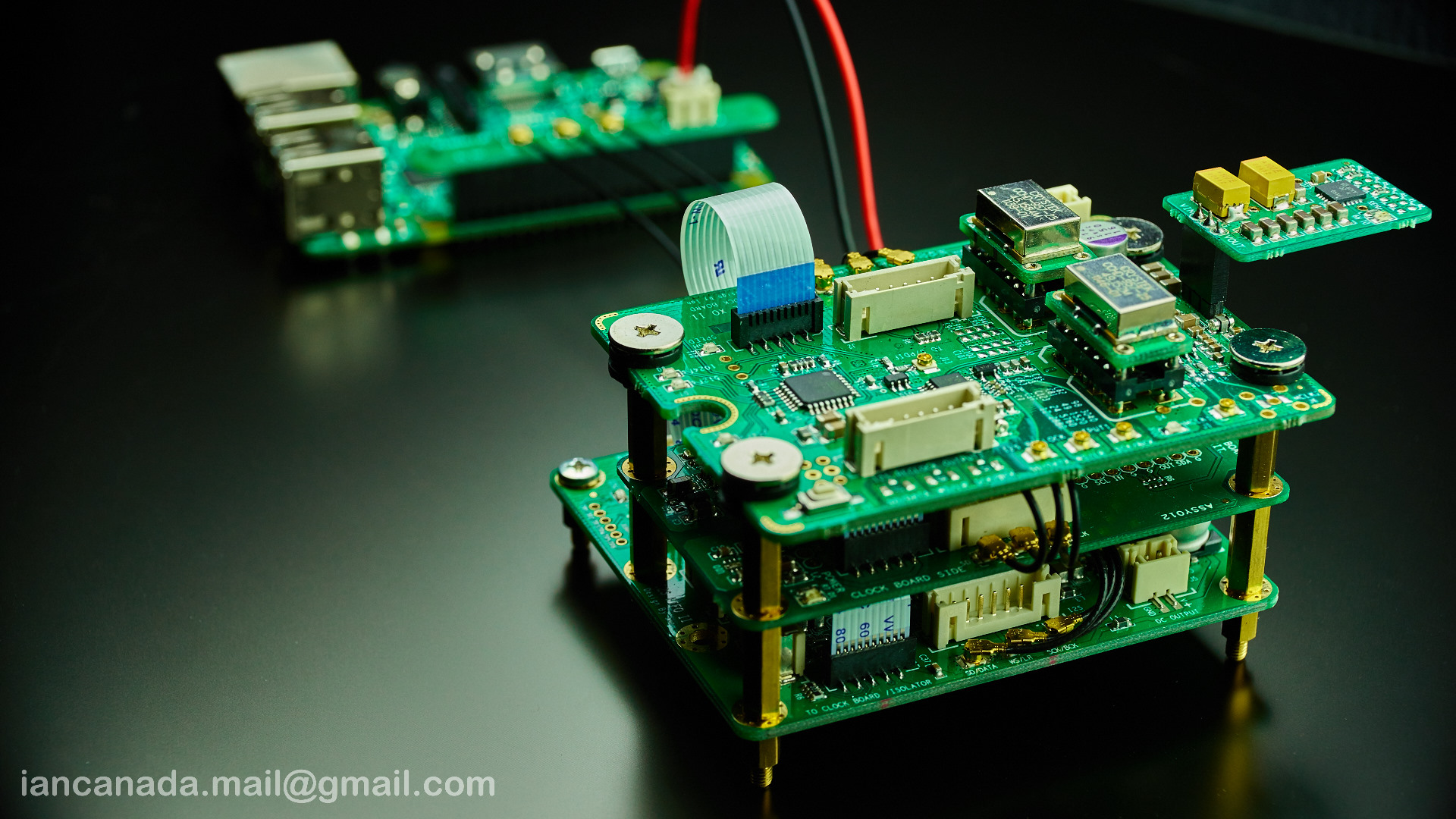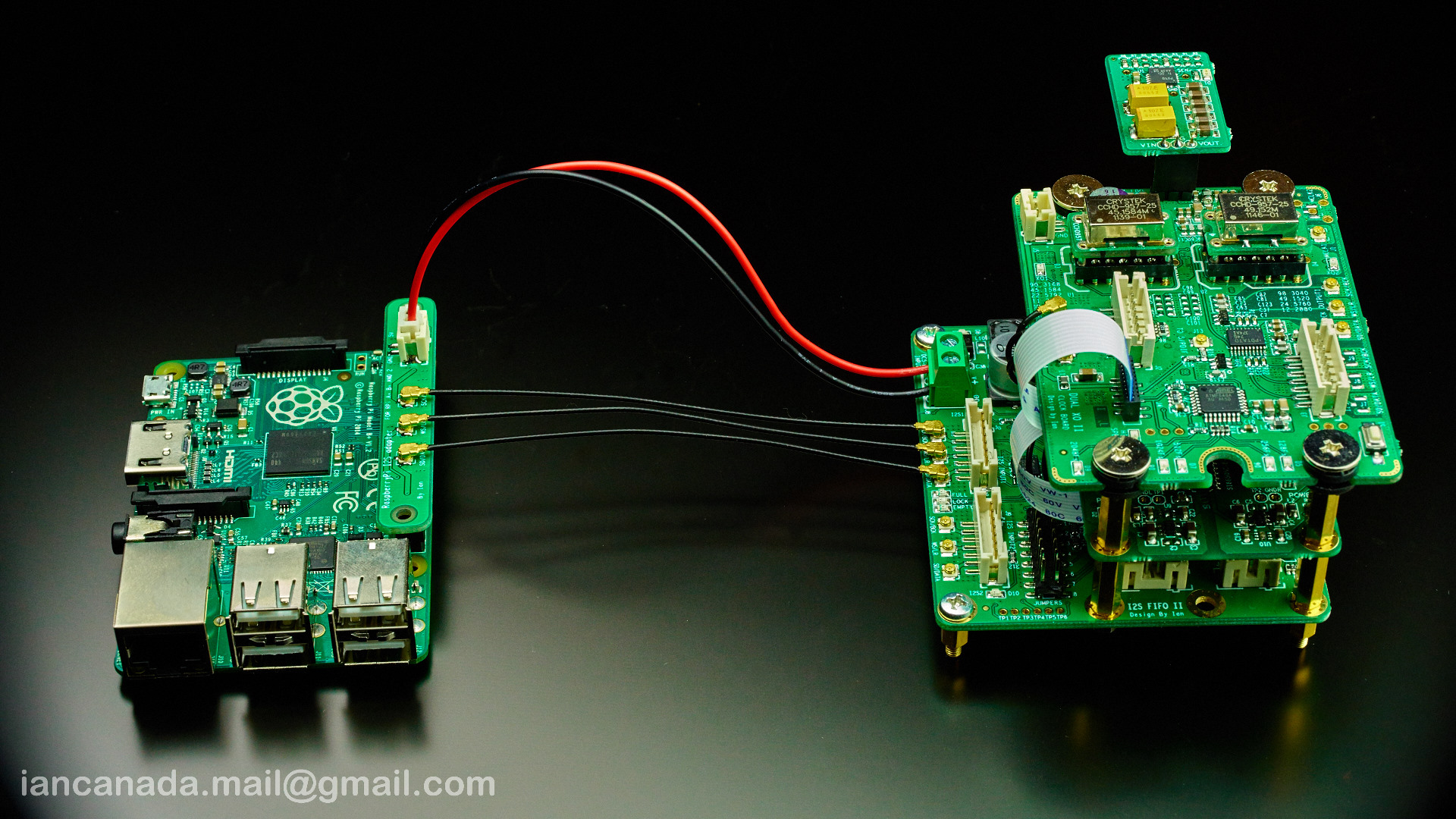Raspberry Pi B+ works perfectly with Ian FIFO II KIT + ESS9018DAC through RPi I2S cap
Yesterday, I hooked up my Raspberry Pi B+ with my FIFO II KIT and following by ESS9018 DAC (synchronize mode) through the new developed RPi I2S cap PCB. Because I have a FIFO isolator after FIFO and an independent battery power for Dual XO II clock board, I picked up 5V power supply directly from Raspberry Pi to FIFO II without affect any on the sound quality. The sound was so good. Raspberry plays music like a charm. All drawback of Pi as a music player was gone. Both RuneAdudio and Volumio software image work for Ian FIFO KIT
Now, Raspberry Pi has external low jitter clocks on the FIFO clock board as well as MCLK output. Any high-end DIY DACs can be easily connected to under this configuration. Pi Jitter performance is no longer decided by its internal PLL, but XOs on clock board. There is no limitation on MCLK frequencies and clock quality any more. The bad reputation of Pi PLL becomes nothing now. Additional I2S inputs such as S/PDIF board, USB streamer, and something else can also work together with Raspberry Pi under this configuration with FIFO II. Good low jitter clocks on Dual XO II will work for all music sources at same quality in this case. Raspberry Pi becomes an amazing audiophile grade music player.
Since I already confirmed that this Raspberry Pi I2S cap PCB is functional, I will share 30 of them with diyAudio members for free very soon. I’ll put a note on this thread once they are ready for ship. Please keep watch and send message to me at that time. Or, please follow my Twitter @iancanadaTT for any new updates.
Have fun with the $25/$35 Raspberry Pi B+/2 music player and the huge RPi community support.

DSC02815C1Pro by Ian, on Flickr

DSC02817C1Pro by Ian, on Flickr

DSC02821C1Pro by Ian, on Flickr

DSC02831C1Pro by Ian, on Flickr
Ian
Yesterday, I hooked up my Raspberry Pi B+ with my FIFO II KIT and following by ESS9018 DAC (synchronize mode) through the new developed RPi I2S cap PCB. Because I have a FIFO isolator after FIFO and an independent battery power for Dual XO II clock board, I picked up 5V power supply directly from Raspberry Pi to FIFO II without affect any on the sound quality. The sound was so good. Raspberry plays music like a charm. All drawback of Pi as a music player was gone. Both RuneAdudio and Volumio software image work for Ian FIFO KIT
Now, Raspberry Pi has external low jitter clocks on the FIFO clock board as well as MCLK output. Any high-end DIY DACs can be easily connected to under this configuration. Pi Jitter performance is no longer decided by its internal PLL, but XOs on clock board. There is no limitation on MCLK frequencies and clock quality any more. The bad reputation of Pi PLL becomes nothing now. Additional I2S inputs such as S/PDIF board, USB streamer, and something else can also work together with Raspberry Pi under this configuration with FIFO II. Good low jitter clocks on Dual XO II will work for all music sources at same quality in this case. Raspberry Pi becomes an amazing audiophile grade music player.
Since I already confirmed that this Raspberry Pi I2S cap PCB is functional, I will share 30 of them with diyAudio members for free very soon. I’ll put a note on this thread once they are ready for ship. Please keep watch and send message to me at that time. Or, please follow my Twitter @iancanadaTT for any new updates.
Have fun with the $25/$35 Raspberry Pi B+/2 music player and the huge RPi community support.

DSC02815C1Pro by Ian, on Flickr

DSC02817C1Pro by Ian, on Flickr

DSC02821C1Pro by Ian, on Flickr

DSC02831C1Pro by Ian, on Flickr
Ian
Last edited:
Looks good!
By the way, there working on new volumio software, can't wait to try that.
You got a new "stalker" on Twitter LOL
By the way, there working on new volumio software, can't wait to try that.
You got a new "stalker" on Twitter LOL
Is it possible to feed +5V to the Raspberry thru power connector on RPi I2S cap PCB? I'd be happy not to use that micro-usb, or whatever it is, standard cable.
Hi Fralippo,Is it possible to feed +5V to the Raspberry thru power connector on RPi I2S cap PCB? I'd be happy not to use that micro-usb, or whatever it is, standard cable.
Take a look at this. I think your answer is here.
http://raspberrypi.stackexchange.com/questions/1617/how-do-i-supply-power-through-the-gpio
Very nice Ian,superb set,compact but of very high quality.You have note a difference between RuneAudio and Volumio concerning sound quality.
You have note a difference between RuneAudio and Volumio concerning sound quality.
If there was a difference, wouldn't that be an indication that the FIFO isn't working?
If there was a difference, wouldn't that be an indication that the FIFO isn't working?
I love many attributes of the sound when using the FIFO but it does not eliminate differences between sources, cables, OS, PC power supplies. Yet, it certainly does work. How these differences propagate and become audible is a mystery to me.
I should add: my system, my ears, ymmv
Nah. The fifo is perfect. More likely noise by radiation or through PS but outside the direct signal path. Even though my dac has 5 transformers and weighs a ton, some signal/noise coupling must occur.
Nah. The fifo is perfect. More likely noise by radiation or through PS but outside the direct signal path. Even though my dac has 5 transformers and weighs a ton, some signal/noise coupling must occur.
But the player software shouldn't really affect any of those.
From my point of view it is enough that the player software places a different load on the processor and modulates the noise differently. This noise should be eliminated by the galvanic isolation, but how well the isolators work i really don't know. How much radiated noise reaches the dac i also don't know. In fact, i already admitted being mystified.
Hi Fralippo,
Take a look at this. I think your answer is here.
How do I supply power through the GPIO? - Raspberry Pi Stack Exchange
Thanks Zoef, it could be the best answer🙂.
Ian
Very nice Ian,superb set,compact but of very high quality.You have note a difference between RuneAudio and Volumio concerning sound quality.
Thanks Olivier🙂, I did't find any difference on sound quality between RuneAudio and Volumio. For me, RuneAudio seems a bit easier on software setup. But I could be wrong.
Ian
I love many attributes of the sound when using the FIFO but it does not eliminate differences between sources, cables, OS, PC power supplies. Yet, it certainly does work. How these differences propagate and become audible is a mystery to me.
I should add: my system, my ears, ymmv
Hi analog_sa,
FIFO works as a clock isolator. Theoretically, if data keeps no change,anything before FIFO will not affect any to the sound quality . However, in the real world, jitter can still be introduced from something else, such as ground or EMC noise from air(even you have an isolator), but should be much less than directly introduced from original audio clock.
I involved in medical equipment industry for many years. To get FDA certification, each new produce we developed have to pass EMC class B. So I often go to EMC testing labs. You can see everything on the screen of a spectrum analyzer. Your system clock, PLL, switching power supply, DDR memory, BUS, USB, TFT and anything else. Each of those EMC sources are located at different peak point of the spectrum. If we change the firmware, some of peak points will also be changed. All of them were picked up from an antenna in a shield chamber 3 to 5 maters away from our product. Especially the frequency range from 100MHz to 700MHz, very difficult to be suppressed.
That's why sometimes a shield works for a clock board or DAC.
If we put it that way, what your were saying, I think, is really reasonable.
Regards,
Ian
Last edited:
Size of the buffer ? Crystal ?
By this comment it is evident that you still don't know how this works.
//
From my point of view it is enough that the player software places a different load on the processor and modulates the noise differently. This noise should be eliminated by the galvanic isolation, but how well the isolators work i really don't know. How much radiated noise reaches the dac i also don't know. In fact, i already admitted being mystified.
Have you tried to verify the effect with double-blind ABX listening?
FIFO works as a clock isolator. Theoretically, if data keeps no change,anything before FIFO will not affect any to the sound quality . However, in the real world, jitter can still be introduced from something else, such as ground or EMC noise from air(even you have an isolator), but should be much less than directly introduced from original audio clock.
Do we actually know for sure that the effects of noise is actually less than that from the original audio clock? It sounds like a reasonable assumption, but have we verified it?
The reason I am asking is that as long as it is just (informed) speculation, it might actually turn out that it would, for example, be a better solution not to use I2S, but instead a long optical connection (USB?) that places the DAC far away from any other electronics.
Do we actually know for sure that the effects of noise is actually less than that from the original audio clock?
Julf, what do you mean by this?
//
Do we actually know for sure that the effects of noise is actually less than that from the original audio clock? It sounds like a reasonable assumption, but have we verified it?
The reason I am asking is that as long as it is just (informed) speculation, it might actually turn out that it would, for example, be a better solution not to use I2S, but instead a long optical connection (USB?) that places the DAC far away from any other electronics.
Hi Julf,
I myself can not hear any difference related to this possible effect on my system. But due to my EMC/EMI testing experience, I think it's probably reasonable if some one can really feel it.
The best way to isolate two parts of circuit is optical. However, it's very hard to find optical transmitter/receiver with low jitter features. In this way, I don't think optical cable is good for clock signals. The best approach could be that: Making clock/re-clocking circuits as close as possible to a DAC, or as part of DAC, anything before DAC, including FIFO , are isolated by optical cables. The secondary clock of FIFO will also be fed from DAC by optical cable. In this case,any EMI noise could be minimized. But it could be complicated to implement. I'll try to find suitable high speed optical fibre transmitter/receivers once I have time to see if they work for audio applications.
Ian
- Home
- Source & Line
- Digital Line Level
- Asynchronous I2S FIFO project, an ultimate weapon to fight the jitter